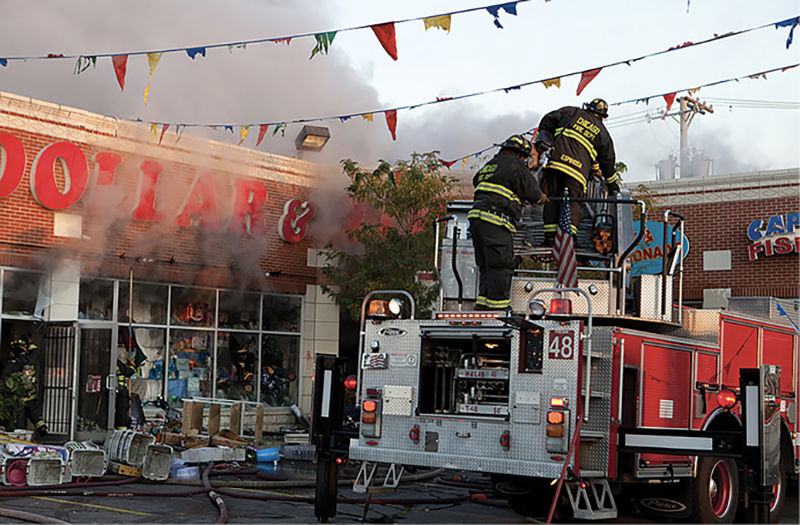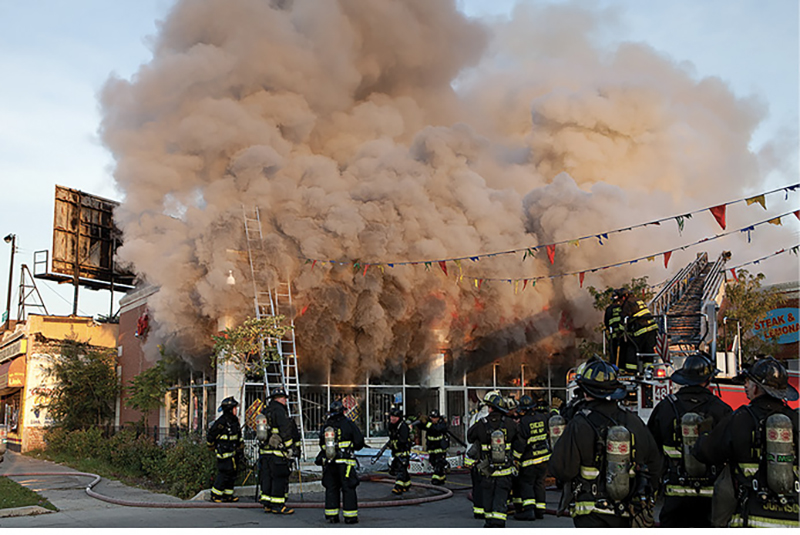TRAINING NOTEBOOK ❘ By Bill Gustin
This article will examine factors firefighters must constantly consider when operating at fires in discount, auto parts, and convenience stores as well as similar occupancies to ensure that firefighters are not operating at an excessive, unjustifiable level of risk.
- The Hometown Box Store
- Fighting Small and Medium-Sized Box Store Fires with Limited Personnel
- 10 Commandments for Operations in Small Box Stores with Limited Staffing
Fire Load
When examining fire loads, we must consider the following three factors:
- The amount of fuel.
- The type of fuel.
- The way the fuel is stored.
A discount store’s fire load is a “perfect storm” for intense fires; it is crammed with lightweight plastic merchandise, made primarily in China. Plastics have extremely high-heat release rates and, since a lot of it is hanging from racks or stacked on shelves, there is plenty of surface exposed to rapidly spread a fire.
Consider the fire loading of an auto parts store; these stores are stocked with aerosol cans containing flammable propellent gases and, often, flammable contents such as lubricants, solvents, and paint. Aerosol cans are known to become flaming rockets that spread fire to other areas of the store. This raises the question: Since the fire load in discount and auto parts stores is so high, why aren’t they required to be protected by a sprinkler system?
Sprinkler requirements vary with each jurisdiction. In Miami-Dade County, Florida, sprinklers are not required in mercantile occupancies under 12,000 square feet (sf). This is the reason it is rare to find a discount or auto parts store exceeding the dimensions of 100 × 100 feet, or 10,000 sf.
Risks to Civilians and the Duty to Act
Firefighters must consider not only the fire load but the occupant load of discount stores, which are notorious for being overcrowded or having aisles cluttered with merchandise and locked exits secured with a bar or chain or blocked with stock.


(1, 2) Chicago (IL) Fire Department (CFD) firefighters operating at this discount store fire contend with an extremely high fire load of merchandise and cluttered conditions, which are common difficulties associated with fires in these types of mercantile occupancies. (Photos by Steve Redick.)
Exits blocked with full, empty cardboard boxes become a bigger problem around the holidays. A fire in a crowded discount store has the potential to put customers at risk. Customers attempting to escape could be trapped by blocked exits or take refuge in an office or restrooms. Firefighters finding these conditions should operate as if the fire is in a crowded nightclub with fire involving combustible decorations. So, get tank water on the fire as rapidly as possible and commit exterior companies equipped with metal-cutting saws to force open side and rear exits.
There’s no question that firefighters performing a fast attack in a commercial occupancy operate at an elevated level of risk. However, in this case, the risk is justifiable because of the risk to civilians. Once firefighters are reasonably certain that all occupants have been evacuated, the fire becomes a different animal. Companies should be withdrawn immediately and shift to commercial firefighting tactics and strategy; then, the risk of a fast attack is no longer justified.
Let’s say an engine company responds on a medical call for a slip and fall in a discount store on the Saturday before Christmas. On arrival, the company officer finds the store overcrowded, the aisles congested with stock items, and blocked exits. What is the fire department’s protocol for reporting and correcting these serious code violations? There had better be something in place because, as a fire officer, you have a duty to act. Referring the violations to the Fire Prevention Bureau to handle on a later day is not good enough and, most likely, will not protect the officer and the fire department from liability if a fire occurs over the weekend that results in civilian deaths and injuries.
Building Construction
Discount stores and similar occupancies are typically of Type II noncombustible construction. There is a vast difference between Type II and Type I—fire resistant construction. Noncombustible construction may not contribute any fuel to a fire (except, perhaps, its roof covering), but structural elements are prone to early collapse when exposed to fire. The exterior walls are typically concrete block, but they could be cladded in corrugated steel on aluminum “C” channel studs.
Roof systems commonly consist of a corrugated metal deck supported by unprotected steel bar joists. Again, these are prone to early collapse unless the underside of the roof is cooled by master streams. Ceilings, if present, do more harm than good; they will do little or nothing to protect the unprotected steel bar joists from fire exposure and their gridwork, suspended from the bar joists, can fall and entangle firefighters.


(3, 4) Deep-seated fire is difficult to control with hoselines because of cluttered conditions. Here, CFD’s Tower Ladder 5 directs its master stream for reach and penetration of the burning merchandise.
Whether there is a ceiling or not, light fixtures and ventilation ductwork will pose a similar entanglement hazard. The space between a ceiling and the underside of a roof can become a reservoir for hot, unburned fire gases that are oxygen deficient. Opening a ceiling from below could be like opening the damper of a wood-burning stove; it could precipitate a backdraft. When the presence of a ceiling is confirmed by a thermal imaging camera, it should be opened immediately inside the door where firefighters gain entry. Pulling a suspended ceiling may not be necessary because a powerful stream will usually push up ceiling panels or bring them down. Additionally, you can examine the space above the ceiling by simply pushing up a panel with the blunt end of a pike pole. Consider the height of ceilings in mercantile occupancies, which are commonly beyond the reach of a six-foot hook.
Façades
Mansard façades and other overhangs at the front of commercial buildings are generally not integral components of the building’s roof construction. Commercial façades are commonly fastened to the front parapet above the show windows. “Bolt-on” façades can fail at one end of a storefront, precipitating a collapse of the entire assembly.
Firefighters operating on the sidewalk in front of a strip mall have been caught in the collapse of a façade even though they were in flanking positions, positioned in front of uninvolved occupancies. Also, avoid laddering front façades; they can extend several feet above the roof, necessitating the use of a ladder to climb down to reach it.
Fire Dynamics
Petroleum-based petrochemical materials (plastics) burn with a voracious appetite for oxygen. In a closed commercial burning, a fire will consume the available oxygen and become ventilation controlled or limited, depleting the oxygen leg of the fire triangle. So, treat fires in closed commercial occupancies as if there is an angry dragon sleeping inside. The heat is there, the fuel is there, and—in a very dangerous phase—in the form of extremely volatile, unburned products of incomplete combustion such as vapors, gases, and aerosols. What is missing is oxygen that will flow into the building when firefighters force entry. This new supply of oxygen can precipitate a flashover or backdraft.
Tactics and Strategy
When firefighters arrive to a commercial building that is closed for the night and find heated show windows with streaks of soot and droplets of condensation, it is time for them to slow down and take advantage of the dormant state of the fire to buy time to secure an adequate and redundant water supply, properly position apparatus, and ready 2½-inch attack hoselines and master stream devices. Fire officers should consider that the fire could have been burning for hours before it was discovered and reported, so take the time to get it right the first time. This is no place for a fast attack with tank water.
Fire researchers advise not to delay getting water on a residential fire while firefighters secure a water supply. However, a closed store is hardly an occupied residence. Professional firefighters, whether career or volunteer, do not fight fires in all occupancies with the same tactics, the same diameter hoselines, and the same level of aggression. At residential fires, there is a presumption that occupants are unable to self-evacuate. This calls for firefighters to implement an offensive strategy to go to the fire aggressively and attack it to protect occupants and the firefighters searching for them.
This is not the case with fires in closed commercial occupancies, where fires tend to get a lot worse before they get better. At commercial fires, a high level of aggression and associated risk is seldom justified. At a fire in a closed commercial building, where a ventilation-limited fire is likely to rapidly intensify, it may be safer and more effective for firefighters to let the fire come to them so they can fight it on their terms, which means using the reach of streams from 2½-inch hoselines and master stream devices directed from the exterior to suppress it while cooling the underside of the roof.
Ventilating Show Windows
Fire researchers have proven that ventilation without fire control makes conditions worse. Use caution when breaking show windows; doing so could precipitate a backdraft or, at least, a rapid intensification of the fire. Firefighters must be ready with 2½-inch handlines and master streams operated from flanking positions, not in front of the show windows. Occasionally, firefighters get lucky; the show windows will fail when hit with powerful streams of water. So, it’s definitely worth a try.
When breaking show windows, use the longest pike pole available; this is no job for a six-foot hook. Again, from a flanking position, strike the glass at the top of the window. Although modern codes (usually building codes) require tempered or laminated glass, it could have been replaced illegally with plate glass, which breaks in large shards.
Be sure to clear all the glass from the window because plate glass remaining at the top of a window can suddenly fall like the blade of a guillotine. For example, at a commercial fire, firefighters failed to take all the glass from the top of a tempered glass show window—a critical error! Although tempered glass breaks into small crystals, these show windows were tinted, which held the glass together. Suddenly, a large portion of the glass fell from the top of the window and struck a firefighter in the back of the neck, causing what could have been a career-ending injury.
Not Worth the Risk
Before plans were ever submitted to the building and fire departments for approval, an economic decision was already made to not install sprinklers or a fire-rated ceiling. Although this is purely supposition, perhaps the reason to forgo the expense of fire protection is that the loss of a few stores every year from fire is the cost of “doing business.”
Accordingly, when firefighters encounter heavy fire conditions in a discount, auto parts, or similar mercantile store, they should not attempt to cut a ventilation hole in a metal deck/bar joist roof, which can collapse in a matter of minutes. Similarly, they don’t belong under it, performing an aggressive interior attack. It’s not worth the risk.
BILL GUSTIN is a 50-year veteran of the fire service and a captain with Miami-Dade (FL) Fire Rescue. He began his fire service career in the Chicago area and is a lead instructor in his department’s Officer Development Program. He teaches tactics and company officer training programs throughout North America. He is a technical editor and an advisory board member of Fire Engineering and FDIC International.

